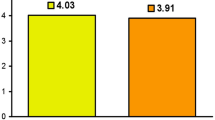Abstract
The objective of this research was to determine the effects of wellness programs on quality of life and utilization in an academic family medicine practice in two small controlled studies. One offered stress management and problem solving; the second offered a broader wellness intervention. Outcome measures consisted of scores on the Beck Anxiety Inventory, Hamilton Depression Inventory, CES-D (depression), Health Related Quality of Life, SF-12, and the number of office visits in 6 months. Subjects were randomly assigned to intervention or control groups. Statistical analysis compared pre-test and post-test values of the dependent variables between groups. In study one, where the focus was on relaxation, significant differences between groups were observed in anxiety at post-test (p < .03); the intervention group had lower anxiety levels. In study two which had a more general focus, significant group differences were found in days of poor mental health and number of days of depressed mood; the intervention group had fewer days of poor mental health (p < .05) and depression (p < .05) at post-test. No differences were found in utilization in either study. Based on the results of this research, short term wellness programs can be implemented in family practice and are effective in improving quality of life, but not in deceasing utilization in family practice patients. Matching the design of the program to specific patient needs may increase retention and effectiveness.
Similar content being viewed by others
References
Aldana, S. G., Merrill, R. M., Price, K., Hardy, A., & Hager, R. (2005). Financial impact of a comprehensive multisite workplace health promotion program. Preventive Medicine, 40, 131–137. doi:10.1016/j.ypmed.2004.05.008.
American Dietetic Association. (2002). Position of the American Dietetic Association: The role of dietetics professionals in health promotion and disease prevention. Journal of the American Dietetic Association, 102, 1680–1687. doi:10.1016/S0002-8223(02)90359-7.
Beck, A. T., Epstein, N., Brown, G., & Steer, R. A. (1988). An inventory for measuring clinical anxiety: Psychometric properties. Journal of Consulting and Clinical Psychology, 56, 893–897. doi:10.1037/0022-006X.56.6.893.
Bohannon, R. W., Maljanian, R., & Goethre, J. (2003). Screening for depression in clinical practice: Reliability and validity of a five-item subset of the CES-depression. Perceptual and Motor Skills, 97, 855–861. doi:10.2466/PMS.97.7.855-861.
Bombardier, C. H., & Buchwald, D. (1996). Chronic fatigue, chronic fatigue syndrome and fibromyalgia. Disability and health care use. Medical Care, 34(9), 924–930. doi:10.1097/00005650-199609000-00005.
Brennan, J., & Perlman, L. (2004). Expanding psychology using a wellness approach. The Ohio Psychologist, 51, 8–10.
Davis, M., Eshelman, E. R., & McKay, M. (2000). The relaxation and stress reduction workbook (pp. 31–34, 83–90) (5th ed.). Oakland, CA: New Harbinger Publications.
Emmen, M. J., Peters, E., Elving, L. D., Bredie, S. J. H., Wollersheim, H., Bleijenberg, G., et al. (2006). A brief behavioral feedback intervention in hospital outpatients with a high cardiovascular risk. Patient Education and Counseling, 60, 32–40. doi:10.1016/j.pec.2004.11.011.
Holmes, T. H., & Rahe, R. H. (1967). The social readjustment rating scale. Journal of Psychosomatic Research, 11, 213–218. doi:10.1016/0022-3999(67)90010-4.
Kersting, K. (2003). Preparing for psychology practice in the year 2020. Monitor on Psychology, 34, 38–39.
Kobak, K., & Reynolds, W. (2000). The Hamilton depression inventory. In E. M. Maruish (Ed.), Handbook of psychological assessment in primary care settings (pp. 423–461). Mahwah, NJ: Lawrence Erlbaum.
Kouzis, A. C., & Eaton, W. W. (1998). Absence of social networks, social support and health services utilization. Psychological Medicine, 28, 1301–1310. doi:10.1017/S0033291798007454.
Lynch, D. J., McGrady, A., Alvarez, E., & Forman, J. (2005). Recent life changes and medical utilization in an academic family practice. The Journal of Nervous and Mental Disease, 193, 633–635. doi:10.1097/01.nmd.0000177778.27069.77.
Moss, D. (2003). Mind-body medicine, evidence-based medicine, clinical psychophysiology, and integrative medicine. In D. Moss, A. McGrady, T. C. Davies, & I. Wickramasekera (Eds.), Handbook of mind-body medicine for primary care (pp. 3–18). Thousand Oaks, Calif: Sage.
Nezu, A. M., Nezu, C. M., & Perri, M. G. (1989). Problem-solving therapy for depression: Theory, research and clinical guidelines. Oxford, England: Wiley.
O’Donnell, M. (2004). Health-promotion behaviors that promote self-healing. Journal of Alternative Complementary Medicine, 1(Suppl 10), S49–S60. doi:10.1089/1075553042245809.
Prochaska, J. E., & DiClemente, C. (1982). Transtheoretical therapy: Toward a more integrative model of change. Psychotherapy: Theory. Research and Practice, 19, 276–287.
Radloff, L. S. (1977). The CES-D scale: A self-report depression scale for research in the general population. Applied Psychological Measurement, 1, 385–401. doi:10.1177/014662167700100306.
Rahe, R. H., Taylor, C. B., Tolles, R. L., Newhall, L. M., Veach, T. L., & Bryson, S. (2002). A novel stress and coping workplace program reduces illness and healthcare utilization. Psychosomatic Medicine, 64, 278–286.
Ryan, M., & Gevirtz, R. (2004). Biofeedback-based psychophysiological treatment in a primary care setting: An initial feasibility study. Applied Psychophysiology and Biofeedback, 29(2), 79–93. doi:10.1023/B:APBI.0000026635.03016.ef.
Taylor, V. (2000). Measuring healthy days (electronic resource): Population assessment of health-related quality of life. In: US Dept. of Health & Human Services CfDCaP. Nat. Ctr. For Chronic Disease Prevention & Health Promotion, Div. of Adult & Community Health (ed).
Ware, J. E., Snow, K. K., Kosinski, M., & Gandek, B. G. (1993). SF-36 health survey: Manual and interpretation guide. Boston: Health Institute, New England Medical Center.
Ware, J. J., Kosinski, M., & Keller, S. D. (1996). A 12-item short-form health survey: Construction of scales and preliminary tests of reliability and validity. Medical Care, 34, 220–233. doi:10.1097/00005650-199603000-00003.
Williams, K. A., Kolar, M. M., Reger, B. E., & Pearson, J. C. (2001). Evaluation of a wellness-based mindfulness stress reduction intervention: A controlled trial. American Journal of Health Promotion, 15, 422–432.
Author information
Authors and Affiliations
Corresponding author
Rights and permissions
About this article
Cite this article
McGrady, A., Brennan, J. & Lynch, D. Effects of Wellness Programs in Family Medicine. Appl Psychophysiol Biofeedback 34, 121–126 (2009). https://doi.org/10.1007/s10484-009-9084-3
Received:
Accepted:
Published:
Issue Date:
DOI: https://doi.org/10.1007/s10484-009-9084-3




